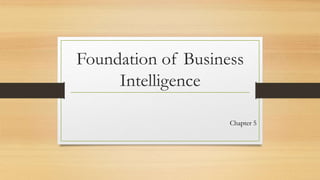
Chapter5
- 2. File organization concept • Computer system organizes data in a hierarchy • Field: Group of characters as word or number • Record: Group of related fields • File: Group of records of same type • Database: Group of related files • Record: Describes an entity • Entity: Person, place, thing on which we store information • Attribute: Each characteristic, or quality, describing entity
- 4. Problems with the traditional file environment (files maintained separately by different departments) – Data redundancy: • Presence of duplicate data in multiple files – Data inconsistency: • Same attribute has different values – Program-data dependence: • When changes in program requires changes to data accessed by program – Lack of flexibility – Poor security – Lack of data sharing and availability
- 5. BI is the process of transforming data into information
- 6. Using databases to improve business performance and decision making • Business Intelligence: • Tools for consolidating, analyzing, and providing access to vast amounts of data to help users make better business decisions • Principle tools include: • Software for database query and reporting • Online analytical processing (OLAP) • Data mining
- 8. • Database • Serves many applications by centralizing data and controlling redundant data • Database management system (DBMS) • Interfaces between applications and physical data files • Separates logical and physical views of data • Solves problems of traditional file environment • Controls redundancy • Eliminates inconsistency • Uncouples programs and data • Enables organization to centrally manage data and data security
- 9. • Relational DBMS • Represent data as two-dimensional tables called relations or files • Each table contains data on entity and attributes Table: grid of columns and rows • Rows (tuples): Records for different entities • Fields (columns): Represents attribute for entity • Key field: Field used to uniquely identify each record • Primary key: Field in table used for key fields • Foreign key: Primary key used in second table as look-up field to identify records from original table
- 10. The composition of a BI
- 11. Business Intelligence in the Enterprise • Business intelligence • Infrastructure for collecting, storing, analyzing data produced by business • Databases, data warehouses, data marts • Business analytics • Tools and techniques for analyzing data • OLAP, statistics, models, data mining
- 12. Business Intelligence And Analytics For Decision Support
- 13. • Very large databases and systems require special capabilities, tools • To analyze large quantities of data • To access data from multiple systems • Three key techniques 1. Data warehousing 2. Data mining 3. Tools for accessing internal databases through the Web
- 14. • Data warehouse: – Stores current and historical data from many core operational transaction systems – Consolidates and standardizes information for use across enterprise, but data cannot be altered – Data warehouse system will provide query, analysis, and reporting tools
